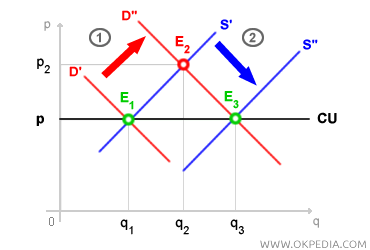Constant Cost Industry
A constant cost industry is a situation in long-run equilibrium where average costs remain unchanged regardless of production levels. Even as production increases, average costs stay the same, which also means that the selling price of the good remains constant. This scenario can be visualized on a Cartesian plane, with the industry's production quantity on the x-axis and the product price on the y-axis.

The market initially reaches equilibrium at point E1. A sudden rise in demand (phase 1) shifts the demand curve to the right, creating a new equilibrium at point E2. However, because this is a long-run analysis, the equilibrium at E2 is only temporary. At this point, firms in the industry experience supernormal profits, which are represented by the difference between the new market price (P2) and the average cost of production (CU). These profits attract new competitors to the market, leading to an increase in supply (phase 2) as long as the selling price remains higher than the average costs. This shifts the supply curve to the right. The long-run equilibrium is finally restored at point E3, where supply equals demand and the price matches the average cost of production. At this stage, no new firms enter the market, and the economic equilibrium becomes stable.
